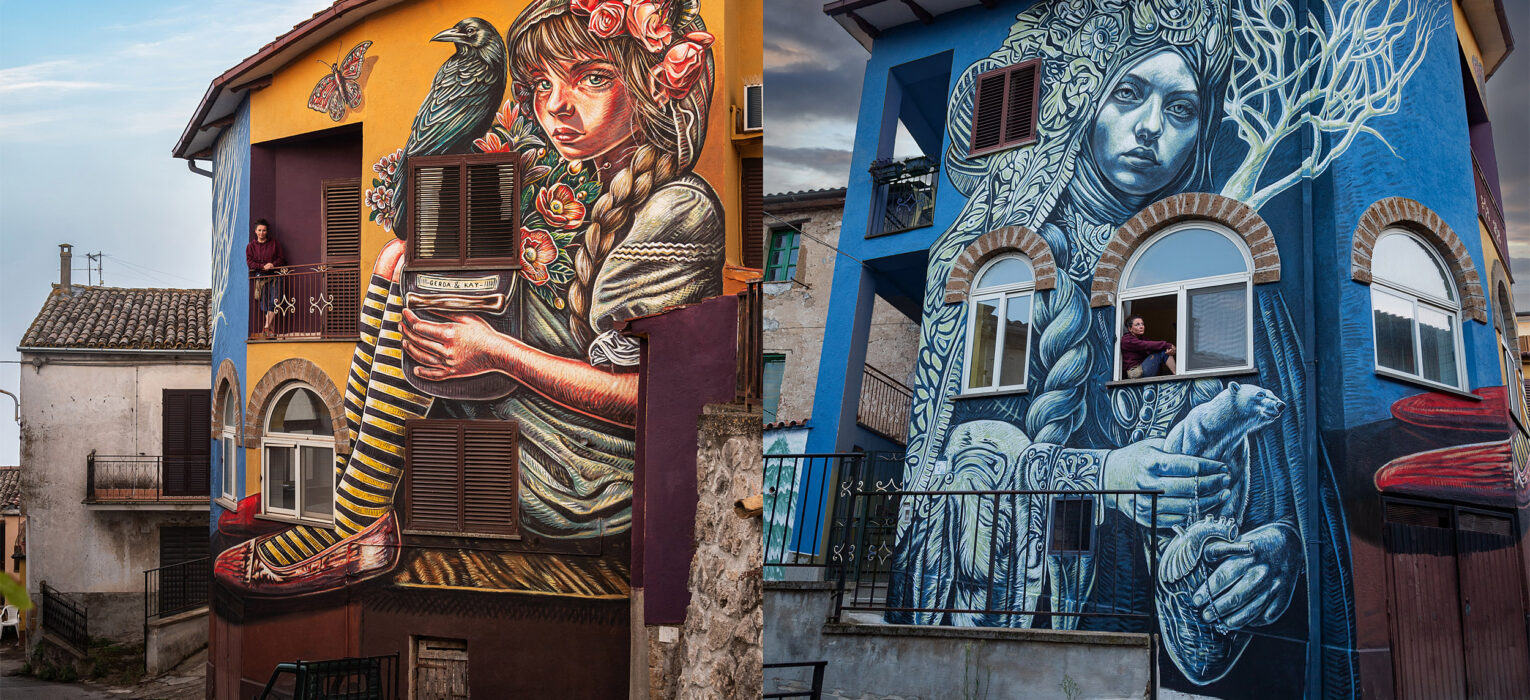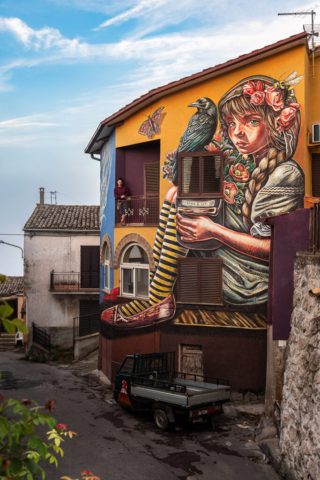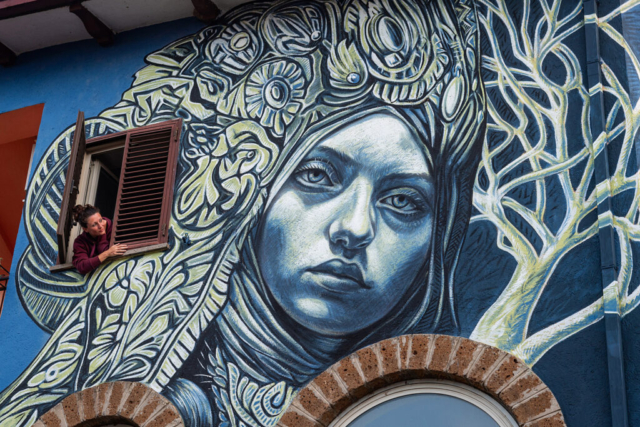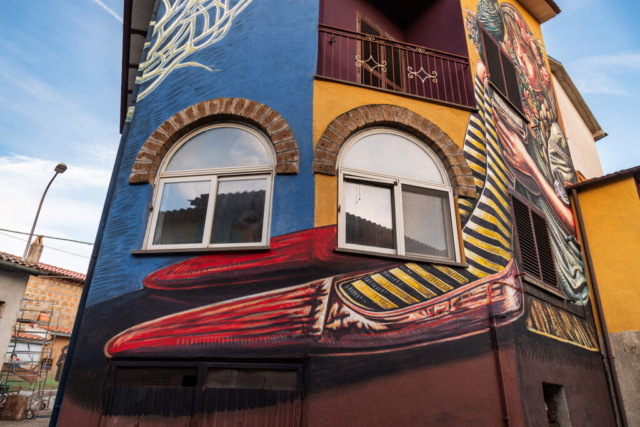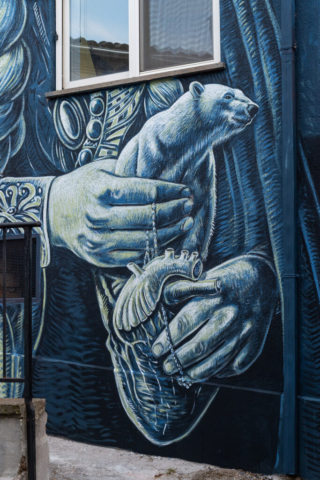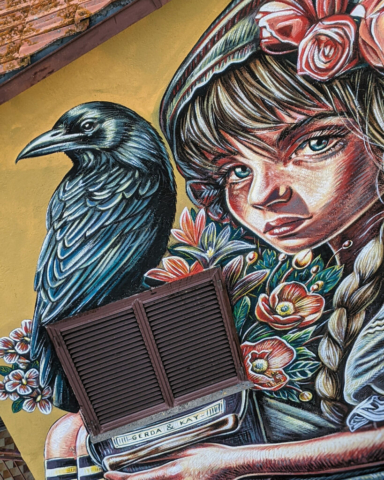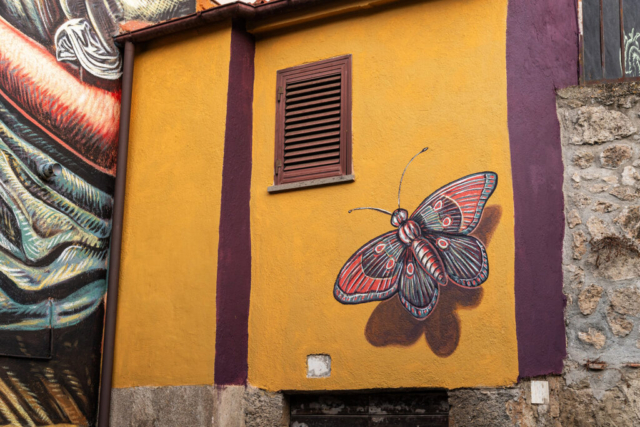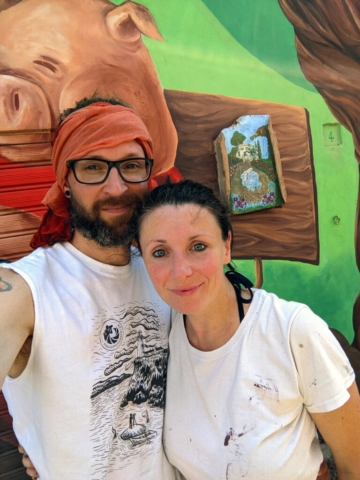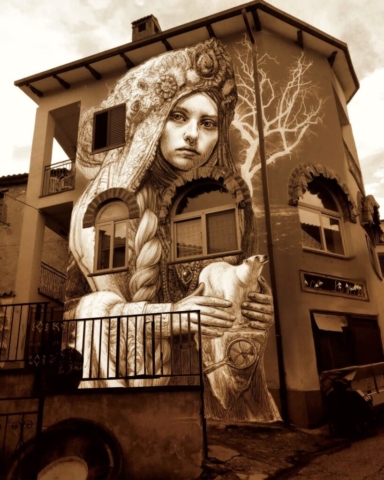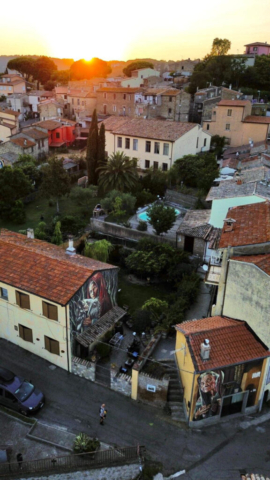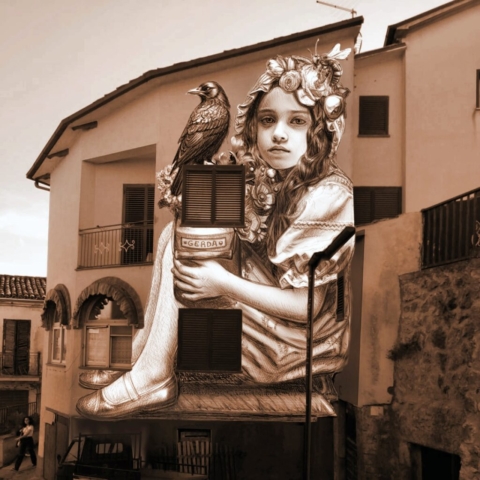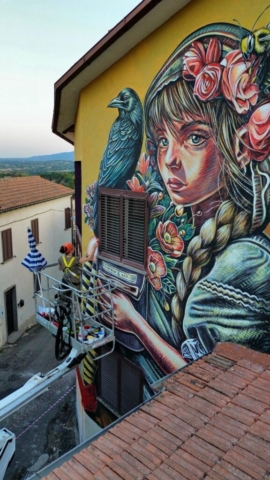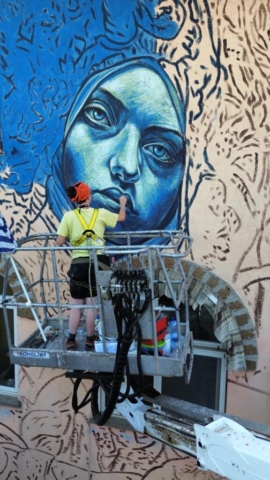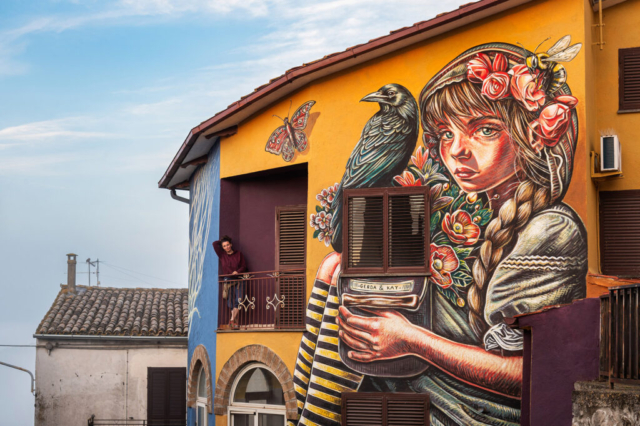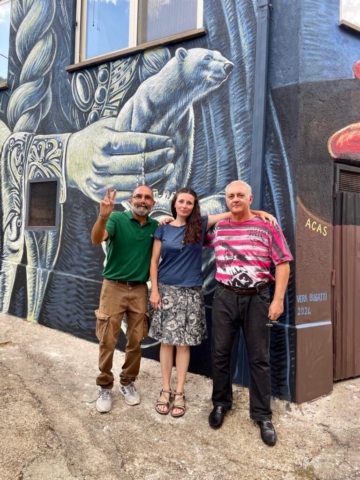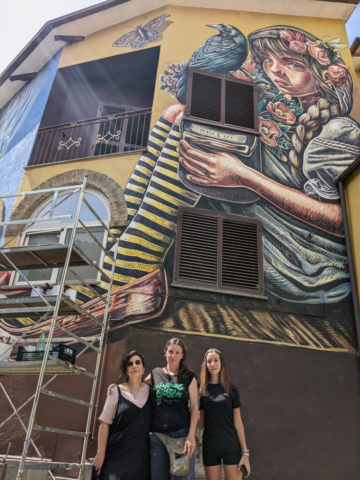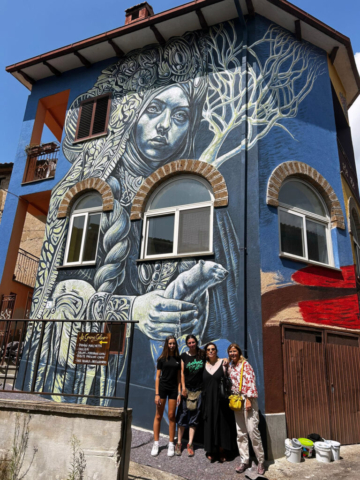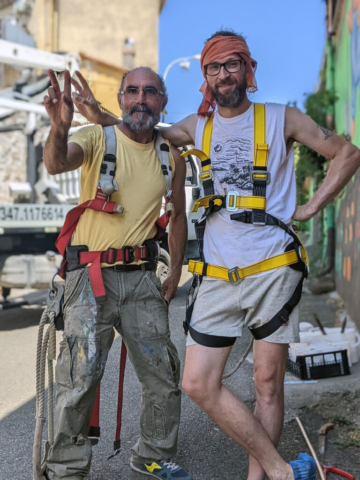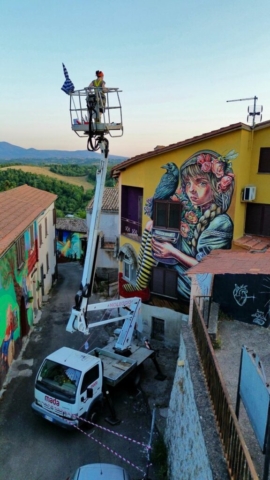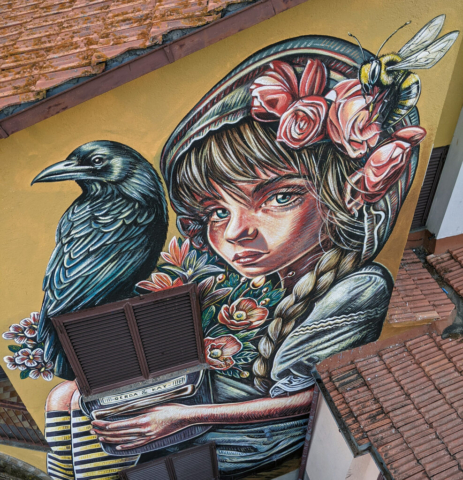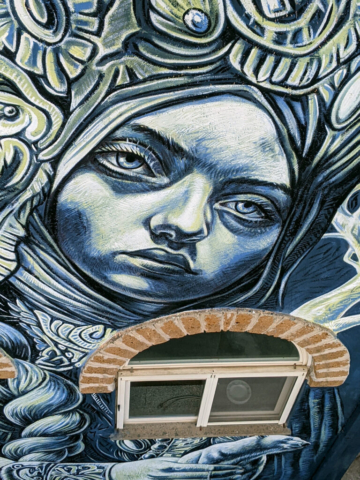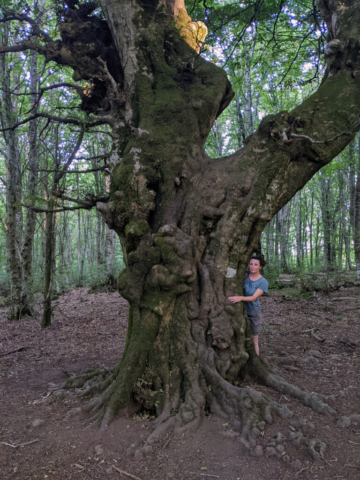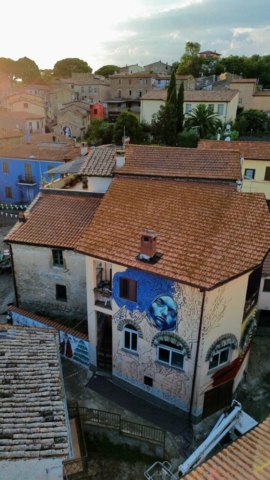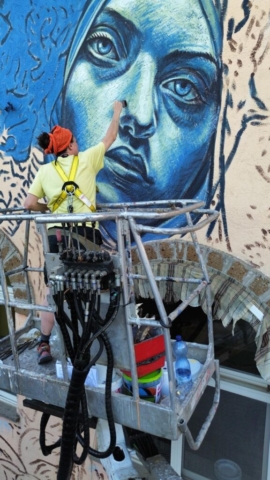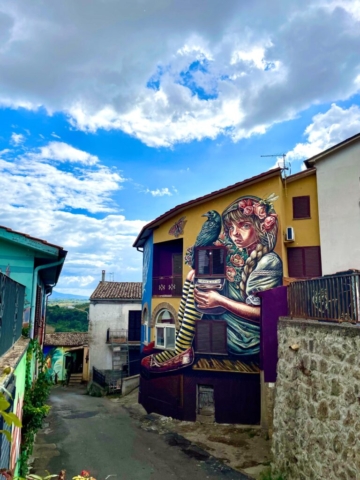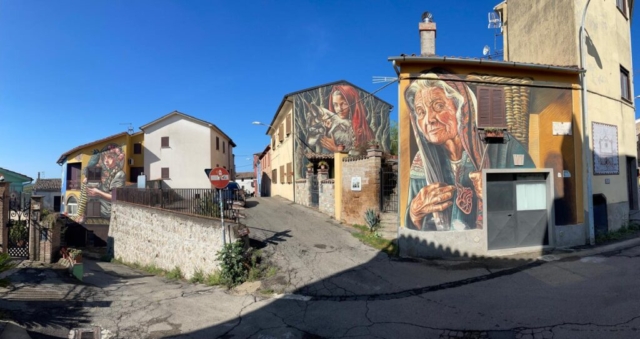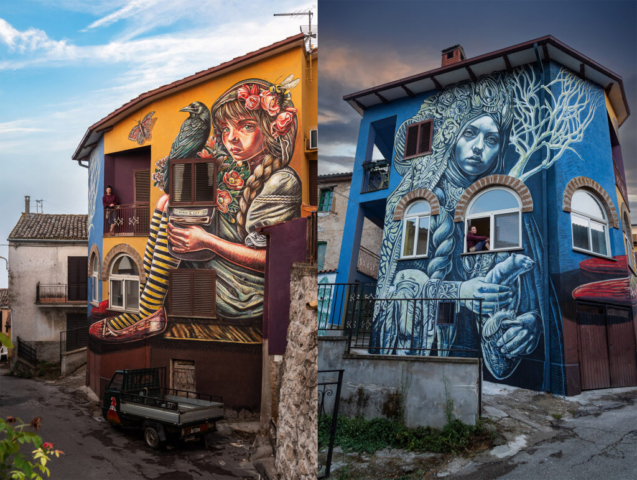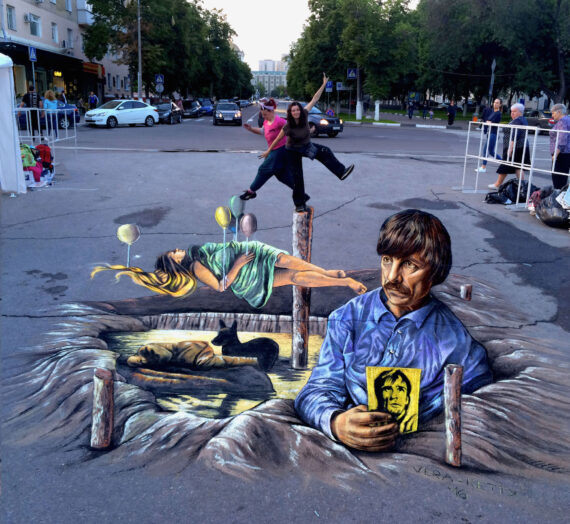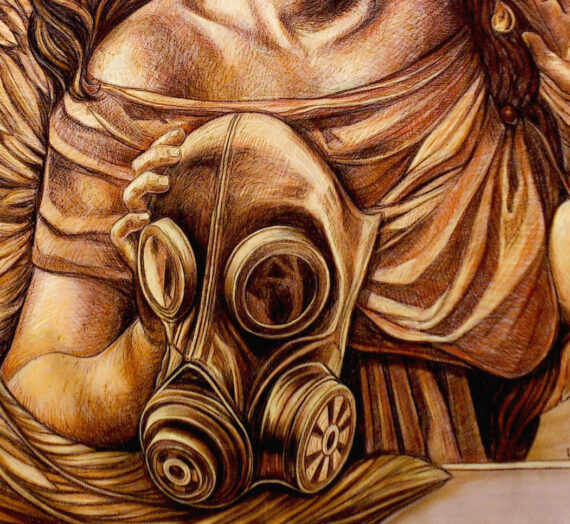“Le rose non perdono il profumo mai e amici per sempre saran Gerda e Kai”
Equilibrio sottile è un’interpretazione della La regina delle nevi (Sneedronningen) di Hans Christian Andersen, pubblicata nel 1844. Il suo sottotitolo è Fiaba in sette storie poiché è divisa in altrettante sezioni, ognuna delle quali descrive una vicenda compiuta.
Vi invito a leggerla in versione integrale perché alcune traduzioni hanno tralasciato elementi curiosi, come l’antefatto: uno specchio diabolico, capace di fare sparire ciò che è buono e di accentuare ciò che è abietto, si rompe in mille frammenti che vengono dispersi per il mondo, entrando negli occhi e nei cuori degli uomini e corrompendo le loro anime.
La mia sintesi della fiaba punta su alcuni elementi simbolo per dare una lettura ambientalista della storia, stimolando una riflessione sul cambiamento climatico e sulla necessità di tutela delle biodiversità.
Due figure femminili, Gerda e la Regina, campeggiano su pareti separate. Stagioni opposte in contraltare armonico e il contrasto fra l’esplosione di colori e la monocromia fredda, un dialogo quasi mancato.
Un sottile equilibrio regge le scene, guai a togliere un elemento.
La bambina regge un vecchio vaso di metallo da latte colmo di fiori sul quale è posato un corvo. Sulla cuffia ornata di rose semi appassite è attiva un’ape di proporzioni enormi mentre due farfalle dai colori impossibili sono in procinto di spiccare il volo dal muro. La Regina tiene saldamente con una mano un orso polare striminzito e protegge con l’altra uno strano elemento che poi si rivela un cuore malandato, attraversato da crepe. Sul mantello appaiono anomale decorazioni floreali, la neve è scomparsa e un albero spoglio si intravede alle sue spalle. Lei è impotente, non può essere l’antagonista, la responsabilità è altrove.
Gerda e la Regina, i cui sguardi malinconici vedono lontano, non si incontrano mai (come nella fiaba) se non idealmente sulla facciata che condivide – secondo prospettive opposte – rami spogli e uno strano oggetto rosso, poi identificato nelle scarpette anamorfiche della bambina (così lunghe se viste di fronte, si ricompongono se osservate dal punto corretto).
La parete di Gerda, rimandando alla terza storia (detta del giardino fiorito), dove la ragazzina si rivolge direttamente a vari tipi di fiori – che le rispondono – vorrebbe incoraggiare la tutela della biodiversità e degli ecosistemi, ricordando contemporaneamente l’importanza degli insetti impollinatori.
Il muro della Regina invece, che appare come un enigma silenzioso quasi bidimensionale, rimanda alla questione del riscaldamento globale e al progressivo scioglimento dei ghiacciai, che sta determinando la scomparsa dell’habitat naturale di molti animali tra i quali l’orso polare, divenuto simbolo della crisi climatica.
E lo specchio? Non c’è perché è evidente che ormai siamo diventati ciechi, i frammenti sono ovunque. Siamo di fronte a fenomeni climatici sempre più estremi, frequenti e devastanti, è ormai un dato di fatto.
Da decenni la comunità scientifica ha descritto come il clima del Pianeta stia cambiando in modo preoccupante e come le responsabilità sia principalmente delle attività umane, a cominciare dall’uso massiccio dei combustibili fossili. E’ ancora possibile fare qualcosa?
Nella fiaba Gerda non può ricorrere alla magia ma, con estrema determinazione e coraggio, guidata unicamente da un cuore buono, scioglie la maledizione. E’ caparbia, non ascolta chi le dice che Kai è morto, parte da sola, convince chi incontra dell’assoluta necessità del suo obiettivo, abbandona ciò che ha di prezioso (le scarpette rosse al fiume), dialoga consapevolmente con i fiori e con gli animali, che infine la scortano alla meta.
Mi piacerebbe fossimo tutti come Gerda.
Per questo progetto ringrazio l’Ass. ACAS di Gianluca e Alessandro Chiovelli, Egle Rossetti e tutti quelli che hanno preso a cuore il progetto, Agostino, Emilia, Rita e molti abitanti di San’Angelo.
Un grazie speciale a Daniela Lai, Eleonora e Matteo per aver sostenuto e voluto quest’opera e per aver condiviso con me un momento difficile (è stata più che empatia).
Questo lavoro è nato per desiderio di Tonino e in sua memoria custodirà la casa. Grazie davvero.
Ecco il link al pdf della fiaba, per completezza e per chi volesse leggerla. https://www.google.com/url?sa=t&source=web&rct=j&opi=89978449&url=https://www.andersenstories.com/it/andersen_fiabe/pdf/la_regina_della_neve.pdf&ved=2ahUKEwiwrvrB3bWIAxU09rsIHf9mBJcQFnoECAgQAQ&usg=AOvVaw2WJ3ZNsYH0CiH8E6TfsbeY
(English text)
“Roses never lose their scent and Gerda and Kai will be friends forever”
Subtle Balance is an interpretation of The Snow Queen (Sneedronningen) by Hans Christian Andersen, published in 1844. Its subtitle is Fairy Tale in Seven Stories because it is divided into seven sections, each of which describes a completed story.
I invite you to read it in its entirety because some translations have left out curious elements, such as the background: a diabolical mirror, capable of making what is good disappear and accentuating what is vile, breaks into a thousand fragments that are scattered throughout the world, entering the eyes and hearts of men, corrupting their souls.
My summary of the fairy tale focuses on some symbolic elements to give an environmentalist reading of the story, stimulating a reflection on climate change and the need to protect biodiversity.
Two female figures, Gerda and the Queen, stand out on separate walls. Opposite seasons in harmonious contrast and the contrast between the explosion of colors and the cold monochrome, an almost missed dialogue. A subtle balance holds the scenes, woe betide anyone who removes an element.
The little girl holds an old metal milk jug full of flowers on which a crow is perched. On the cap decorated with half-withered roses, a bee of enormous proportions is active and two butterflies of impossible colors are about to take flight from the wall. The queen holds a stunted polar bear firmly with one hand and protects a strange element with the other, which then turns out to be a battered heart crossed by cracks. Anomalous floral decorations appear on her cloak, the snow has disappeared and a bare tree can be glimpsed behind her. She is helpless, she cannot be the antagonist, the responsibility lies elsewhere.
Gerda and the Queen, whose melancholic gazes see far away, do not meet except ideally on the facade that shares – according to opposite perspectives – bare branches and a strange red object, later identified as the little girl’s anamorphic shoes (so long when seen from the front, they recompose themselves if observed from the correct point).
Gerda’s wall, referring to the third story (called the flower garden), where the little girl speaks directly to various types of flowers – which respond to her – would like to encourage the protection of biodiversity and ecosystems, and at the same time remember the importance of pollinating insects.
The Queen’s wall, on the other hand, which appears as a silent, almost two-dimensional enigma, refers to the issue of global warming and the progressive melting of glaciers, which determines the disappearance of the natural habitat of many animals including the polar bear, which has now become a symbol of the climate crisis.
And the mirror? It isn’t there because it is clear that we have become blind, the fragments are everywhere. We are facing increasingly extreme, frequent and devastating climate phenomena, it is now a fact.
For decades the scientific community has described how the planet’s climate is changing in a worrying way and how the responsibility lies mainly with human activities, starting with the massive use of fossil fuels. Is it still possible to do something?
In the fairy tale Gerda cannot resort to magic but, with extreme determination and guided only by a good heart, she lifts the curse. She is stubborn, she does not listen to those who tell her that Kai is dead, she sets out alone, she convinces those she meets of the absolute necessity of her goal, she abandons what is precious to her (the red shoes at the river), she talks to the flowers and the animals, who consciously escort her to the destination.
I would like us all to be like Gerda.
For this project I sincerely thank the Ass. ACAS, Gianluca and Alessandro Chiovelli, Egle Rossetti and all those who took the project to heart, Agostino and Emilia, Rita and families, many inhabitants of San’Angelo the Land of Fairy Tales (VT).
Special thanks to the artist Daniela Lai, Eleonora, Matteo and their families for supporting and wanting this work and for sharing a difficult moment with me (it was more than empathy).
This work was born out of Tonino’s wish and will keep the house in his memory. Thank you so much.
